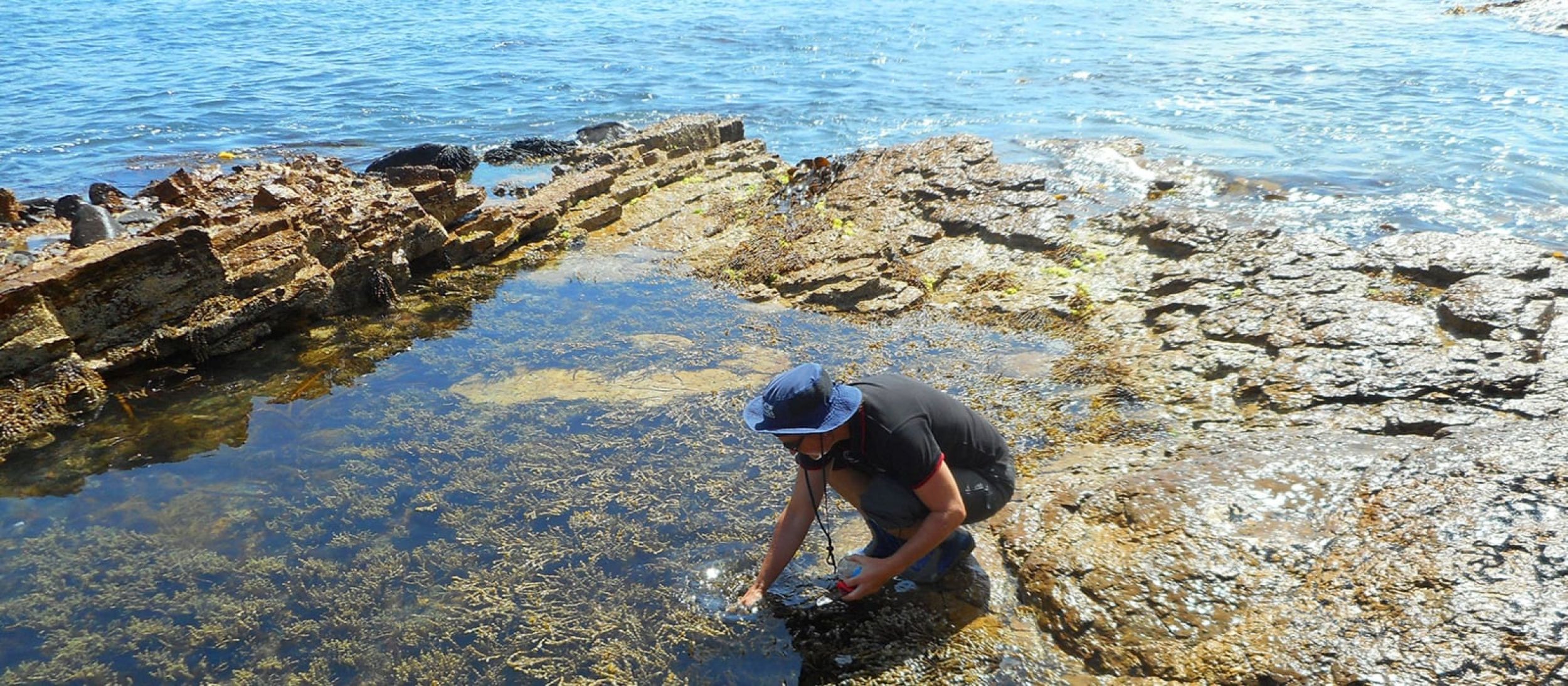
From the Ocean to the Mountains

Earthwatch Australia
Bruny Island TAS Bush Blitz | February 2016
Today’s preparations began around 6:15 am with a quick shower, breakfast and making lunch to take on our adventures. The Bush Blitz teachers were divided amongst the scientists to help them with their collecting. Mary-Ann and I were assigned to Fiona, a marine algae expert, and Kirrily, a marine invertebrate expert.
Our morning saw us head south in convoy with Lynne and Nicky, to Coal Point on the south-eastern side of the island. Lynne is a bugs, leeches and ants expert so she stayed in the scrubby woodland area on the cliff face while Fiona, Mary-Ann, Kirrily and I made our way to the beach. Even though the tide was out, there was very little sand visible at this cove. The cliffs descend almost immediately to a dolerite shelf that juts for a short way into the Southern Ocean and then disappears below the waves. One section of the beach is simply covered with rounded stones, very obviously worn smooth by the constant motion of the waves. The earth layers are evident where erosion has occurred and here, the bush quite literally meets the sea.

We spent close to two hours searching the rocky shelves and intertidal rockpools for algae and invertebrate specimens. Fiona pointed our some very familiar seaweeds – sea lettuce, Neptune’s necklace, bull kelp and dead man’s fingers. Very imaginative names for marine algae. Kirrily identified and collected a multitude of shellfish, sea stars, ascidians and hydroids. I was the specimen jar handler and wave watcher, which may not sound terribly scientific but when the tide is returning, it is a good idea to have someone watch the incoming waves so that those collecting don’t get swamped or washed away. I was blown away by the number of sea stars at Coal Point and their amazing variety of colours.

After our beach adventure we headed further south to Mount Mangana. This mountain is just over 500 metres above sea level and the weather was much colder there. At the top of the mountain we headed off the main road and set up bug traps in amongst the rainforest undergrowth. The scientists use a number of different methods to trap flying and crawling invertebrates and we set up four of those methods. The first was a simple ‘pitfall’ trap. This is a plastic bowl and a plastic lid with a hole in it that is embedded into the ground and covered with earth or debris. Ideally, for the scientist, the bugs fall through the hole and get trapped in the bowl that contains a solution containing ethanol that suffocates the bug, killing and preserving it at the same time. The second method is the ‘shallow pitfall’ trap. This is just a big plastic yellow plate that contains the ether solution. The colour attracts the bug, the bug lands and – you guessed it – the bug dies and is at the same time, preserved in the alcohol solution. The third method is a ‘malaise’ trap. This one is set up and kind of looks like a four pole tent except that each pole has netting attached to it. Click here if you want to find out more about the ‘malaise’ trap.

The last type of trap that we set up was a ‘windscreen’ trap. This is not the technical name but it is the name I am giving to this ingenious invention. Lynne designed and built the trap out of very cheap and found materials to meet her particular collection needs. Lynne was finding that other traps did not preserve the type of bugs that she collects, well enough to collect their DNA so she designed her own trap. The idea is that the flying bugs hit the clear plastic screen that is strung up between two trees. The bugs are stunned and fall down the funnel shaped screen to the tube below (which is actually a fruit juice bottle) and there they are overcome by ethanol fumes and die. Lynne’s unique design stops water from decaying the bug specimens, which is essential for being able to extract DNA, since any water falling into the tube is siphoned away down a funnel. The bugs fall down the funnel because it is covered with fine gauze. Since the ethanol is in a small container underneath the juice bottle it doesn’t evaporate so quickly and the traps can be left out for up to a week. The trap also has a little pitched roof that swings freely at the top to stop leaves from piling up down the catchment tube. Truly amazing ingenuity. I suggested that the next time Lynne has a design problem she could give us a call and let the students see if they can come up with some equally clever solutions. She said she would definitely consider this. Hopefully I can tell you more about what Lynne does after we have a little lesson this evening about bug DNA and adaptation!
As well as Lynne’s lesson, tonight after dinner I will be identifying, sorting and labelling the samples we collected today and pressing some of the algae with Fiona.
I’m not sure what is in store for me tomorrow but whatever it is I know it will be amazing.
Ask any questions you would like the scientists to answer. I will try to get the answers for you as soon as I can.

